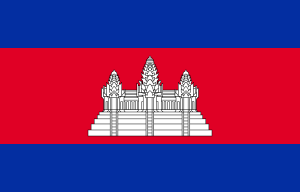Language/Central-khmer/Grammar/Present-Tense
| ◀️ Relationship Status — Previous Lesson | Next Lesson — Past Tense ▶️ |
Welcome to the lesson on the Present Tense in Central Khmer! Understanding the present tense is essential for anyone starting their journey in the Central Khmer language, as it allows you to describe actions happening now. Whether you're talking about your daily routine or sharing your thoughts and feelings, mastering the present tense will help you communicate more effectively.
In this lesson, we will cover the following topics:
Importance of the Present Tense
The present tense is a fundamental aspect of any language. It helps to establish a connection between the speaker and the action or state being discussed. In Central Khmer, using the present tense correctly not only aids in clarity but also enriches conversations. As a beginner, grasping this tense will enable you to engage in simple discussions about everyday life, which is crucial for developing your language skills.
Structure of the Lesson
1. Understanding Present Tense Formation
- Regular verbs
- Irregular verbs
2. Pronunciation Tips
3. Examples of the Present Tense
4. Practice Exercises
5. Solutions and Explanations
Understanding Present Tense Formation
Regular Verbs
In Central Khmer, regular verbs typically follow a consistent pattern when conjugated in the present tense.
Formation Rules:
- Most verbs do not change form based on the subject pronoun.
- The main verb is usually preceded by a subject pronoun.
Here’s a table showcasing some regular verbs in the present tense:
| Central Khmer | Pronunciation | English |
|---|---|---|
| ខ្ញុំេ សូម្បី | kñom soʊmbəɪ | I eat |
| អ្នក សូម្បី | ʔnɛk soʊmbəɪ | You eat |
| គាត់ សូម្បី | kʊət soʊmbəɪ | He/She eats |
| យើង សូម្ពឺ | jɨəŋ soʊmbəɪ | We eat |
| ពួកគេ សូម្បី | puak ke soʊmbəɪ | They eat |
Irregular Verbs
Unlike regular verbs, irregular verbs in Central Khmer may not follow the same predictable patterns.
Here are some examples of common irregular verbs in the present tense:
| Central Khmer | Pronunciation | English |
|---|---|---|
| ខ្ញុំ ដើរ | kñom daə | I walk |
| អ្នក ទៅ | ʔnɛk təʊ | You go |
| គាត់ មើល | kʊət mɨə | He/She sees |
| យើង ស្នាក់ | jɨəŋ snaek | We stay |
| ពួកគេ ប្រាប់ | puak ke brap | They tell |
Pronunciation Tips
Pronunciation in Central Khmer can be challenging for English speakers, so here are a few tips to help you:
- Pay close attention to vowel sounds, as they can change the meaning of words.
- Practice the tonal aspects of the language. Although Khmer is not a tonal language like Mandarin, intonation can affect how words are understood.
- Use language learning apps or online resources to hear native speakers pronounce words and phrases.
Examples of the Present Tense
Let’s look at some additional examples of sentences using the present tense in Central Khmer:
| Central Khmer | Pronunciation | English |
|---|---|---|
| ខ្ញុំ ស្រលាញ់ សាច់ | kñom srəlanh saʔ | I love meat |
| អ្នក សរសេរ សៀវភៅ | ʔnɛk sɑːsɛɨ sɨəv pʰəɨ | You write a book |
| គាត់ លេង កីឡា | kʊət leɨŋ keɨla | He/She plays sports |
| យើង អាន ព័ត៌មាន | jɨəŋ ʔan pʰorɑːmiən | We read news |
| ពួកគេ ចេះ រាំ | puak ke cəh rɑːm | They can dance |
Now that we've established a foundational understanding of the present tense, let's move on to some practice exercises.
Practice Exercises
Exercise 1: Fill in the Blanks
Complete the sentences with the correct form of the verb in the present tense.
1. ខ្ញុំ ______ (ទៅ) ទៅផ្សារ។
2. អ្នក ______ (សរសេរ) សៀវភៅ។
3. គាត់ ______ (ចេះ) រាំ។
4. យើង ______ (មើល) ទូរទស្សន៍។
5. ពួកគេ ______ (ស្រលាញ់) ជីវិត។
Exercise 2: Translation
Translate the following sentences into Central Khmer.
1. I eat rice.
2. You go to school.
3. He sees a dog.
4. We stay at home.
5. They tell stories.
Exercise 3: Pronunciation Practice
Practice pronouncing the following verbs in the present tense:
1. សូម្បី (eat)
2. ដើរ (walk)
3. ទៅ (go)
4. មើល (see)
5. ស្នាក់ (stay)
Exercise 4: Create Sentences
Using the provided verbs, create your own sentences in the present tense.
1. (សរសេរ)
2. (លេង)
3. (អាន)
4. (ប្រាប់)
5. (ចេះ)
Exercise 5: Matching
Match the Central Khmer sentences to their English translations.
1. ខ្ញុំ ស្រលាញ់ កាហ្វេ។
2. អ្នក ម៉ៅលើកន្ទប់។
3. គាត់ សរសេរ ព័ត៌មាន។
4. យើង ឆុងអាហារ។
5. ពួកគេ ធ្វើការងារ។
a. We cook food.
b. I love coffee.
c. They work.
d. You clean the room.
e. He writes news.
Solutions and Explanations
Exercise 1 Solutions
1. ខ្ញុំ ទៅ (I go to the market.)
2. អ្នក សរសេរ (You write a book.)
3. គាត់ ចេះ (He/She can dance.)
4. យើង មើល (We watch TV.)
5. ពួកគេ ស្រលាញ់ (They love life.)
Exercise 2 Solutions
1. ខ្ញុំ សូម្បី អង្ករ។
2. អ្នក ទៅ សាលារៀន។
3. គាត់ មើល ឆ្កែ។
4. យើង ស្នាក់ នៅ ផ្ទះ។
5. ពួកគេ ប្រាប់ រឿង។
Exercise 3 Solutions
- Repeat each verb after listening to a native pronunciation to improve your skills.
Exercise 4 Solutions
- Encourage creativity! Example sentences may vary.
Exercise 5 Solutions
1. b (I love coffee.)
2. d (You clean the room.)
3. e (He writes news.)
4. a (We cook food.)
5. c (They work.)
In conclusion, mastering the present tense in Central Khmer is a vital step in your language learning journey. Regular practice and usage will enhance your confidence in speaking and writing. Remember to engage with native speakers whenever possible, as this will help solidify your understanding and pronunciation.
Happy learning, and see you in the next lesson!
Sources
Other Lessons
- Basic Word Order
- Plurals
- Describing People and Things
- Describing Actions and States
- Pronouns
- Using Prepositions
- Personal Pronouns
- Using Conjunctions
- 0 to A1 Course
- Future Tense
| ◀️ Relationship Status — Previous Lesson | Next Lesson — Past Tense ▶️ |

